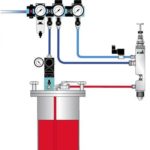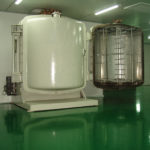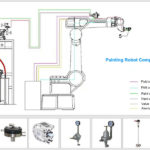The automotive coating process belongs to decorative and protective multi-layer coating, which includes the most processes and the highest coating quality requirements for automotive finishing.
General coating process system
According to the layer of coating, commonly used coating process system include: Two coating systems (primer + topcoat); Three-coating system (primer + middle coat + topcoat or metallic glitter paint/varnish); Four-coating system (primer + middle coat + topcoat + varnish, suitable for luxury cars with higher coating requirements). Generally, the mostly used is the three-coating system, it’s widely used for the body of the car, bus and the cab of the truck with high decorative requirements.
According to the drying conditions, its available as drying system and self-drying system. The drying system is suitable for automobile coating produced by mass assembly line; The self-drying system is suitable for low-volume production of automotive painting and large-size special automotive body painting.
The general coating process of large passenger car and station wagon body is as follows: pretreatment (degreasing, rust removal, cleaning, surface adjustment), ⇒ phosphating ⇒ cleaning and drying ⇒ primer ⇒ drying ⇒ putty rough scraping ⇒ (drying, grinding, wiping) ⇒ putty fine scraping (drying, grinding, wiping) ⇒ middle coating (drying, grinding, wiping) ⇒ trimming (quick-drying priming, drying, grinding, wiping) ⇒ topcoat (drying or varnishing) ⇒ color separation (drying)
Surface treatment process before painting
In order to obtain a high-quality coating, the pre-treatment work that needs to be carried out on the surface of the coated object before painting is called pre-paint surface treatment.The surface treatment before paint is the basis of the coating process, which has a great impact on the quality of the whole coating, mainly including surface cleaning (oil removal, rust removal, dust removal, etc.) and phosphating treatment.
Ways to clean the surface
1- Cleaning with hot lye and scrubbing with solvent to remove oil stains; Use 320-400 mesh sandpaper to polish first then clean with solvent to remove the release agent; The yellow rust should be scrubbed with a cleaning solution prepared with phosphoric acid to ensure that the coating has excellent corrosion resistance and good adhesion on the coated object.
2- Various chemical treatments are applied to the surface of the cleaned coated metal parts to improve the adhesion and corrosion resistance of the paint film. Special chemical treatment is carried out on steel plate parts to improve the adhesion between the paint film and the substrate.
3- Mechanical methods are used to remove machining defects from the coated object and to create the roughness required for the coating film. There are two types of phosphating treatments: spraying and integral immersion. Rapid zinc based phosphating treatment with phosphated film is 1-3g/m, film thickness 1-2μm, the crystal particle size is 1-10μm, and the phosphating can be carried out at low temperature 25-35 °C or medium temperature 50-70 °C
Spray Coating
1- Primer
Primer is the basis of the whole coating, the adhesion between coating and the metal as well as the corrosion protection all depend on it. The primer should be selected with strong anti-rust performance (salt spray ≥ 500h), strong adhesion to the substrate (can adapt to a variety of substrates at the same time), good adhesion to the middle coat or topcoat, and good mechanical properties of the coating film (impact ≥ 50cm, toughness ≤1mm, hardness ≥0.5).
Air based spraying (high-pressure airless spraying can also be selected) to spray the primer, can be sprayed twice by wet on wet method, viscosity 20-30s, the waiting between is 5-10min, flash 5-10min then transfer into the drying chamber, thickness of the primer dry film is 40-50μm.
2- Putty
The purpose of putty is to eliminate the unevenness of the coated object. The putty should be scraped on the dry primer layer. The thickness of one scraping generally does not exceed 0.5mm. The new large-area scraping putty method should be used. This method is easy to even the putty on large area. It is recommended that the putty should be dried and polished smooth every time. Normally the putty should be applied 2-3 times and should be scraped thickly first then scrape it thinly, which can enhance the strength of putty layer and further improve the flatness.
3- Middle Coating
Electrostatic spraying or air based spraying for middle coating can improve the coating film strick resistance, also improve the adhesion with the primer, the flatness and smoothness of the surface to be coated. The mid-coat is generally sprayed by wet-on-wet for two coats, with a construction viscosity of 18-24s, and an interval of 5-10 minutes between each coat. After spraying, it is flashed for 5-10 minutes before transfered into the drying room. The mid-coat dry film thickness is 40-50 μm.
4- Top Coating
The automotive topcoat is normally sprayed using electrostatic or air based spraying that come with excellent weather resistance, vividness and gloss.
Due to the wide range of construction machinery, numorous specifications, huge weight and sizes of the whole machine, spraying is generally used for coating.
Spraying tools include air spray guns, high-pressure airless spray guns, air-assisted spray guns and portable electrostatic spray guns. Air spray guns have low spraying efficiency (about 30%) while high-pressure airless spray guns waste paints. The common feature of both is serious environmental pollution, so they have been and are being replaced by air-assisted spray guns and electrostatic spray guns.
Small and medium-sized parts can use water curtain spray booths or pumpless spray booths. The former has advanced performance while the latter is economical, convenient and practical. Since the complete machinery and parts of construction machinery are heavy and have large heat energy requirement, the drying of coatings generally uses hot air to evenly bake them. The heat source can be selected according to local conditions, including steam, electricity, light diesel, natural gas and LNG etc.
Characteristics and emphases of automotive painting process:
The car painting process has its own characteristics and emphasis depending on the specific mode. The main part of a truck painting is the front cab which has the highest painting requirements; Other parts such as compartments and frames have lower requirements.
The painting of passenger cars is quite different from trucks. The passenger car body includes beams, frames, interior compartments, and outer surfaces of the car body. Exterior surface of car body has higher requirements. The exterior surface of the car body not only requires good protection and decoration, but also has a large spray area, multiple planes, two or more colors, and sometimes automotive ribbons. Therefore, the construction period is longer than that of a truck, the construction requirements are higher than that of a truck, and the construction process is more complicated.
Cars and small station wagons have higher requirements than large buses and trucks in terms of surface decoration or underlying protection. Its surface coating belongs to the first-class decorative precision, with a beautiful appearance, as bright as a mirror or a smooth surface, without minor impurities, scratches, cracks, wrinkles, blisters and visible defects, and also should have sufficient Mechanical strength.
The bottom coating is an excellent protective layer and should have excellent anti-rust and anti-corrosion properties with strong adhesion; partially or entirely scrape-coat putty with good adhesion and high mechanical strength, and no rust or corrosion will occur after several years of use.




